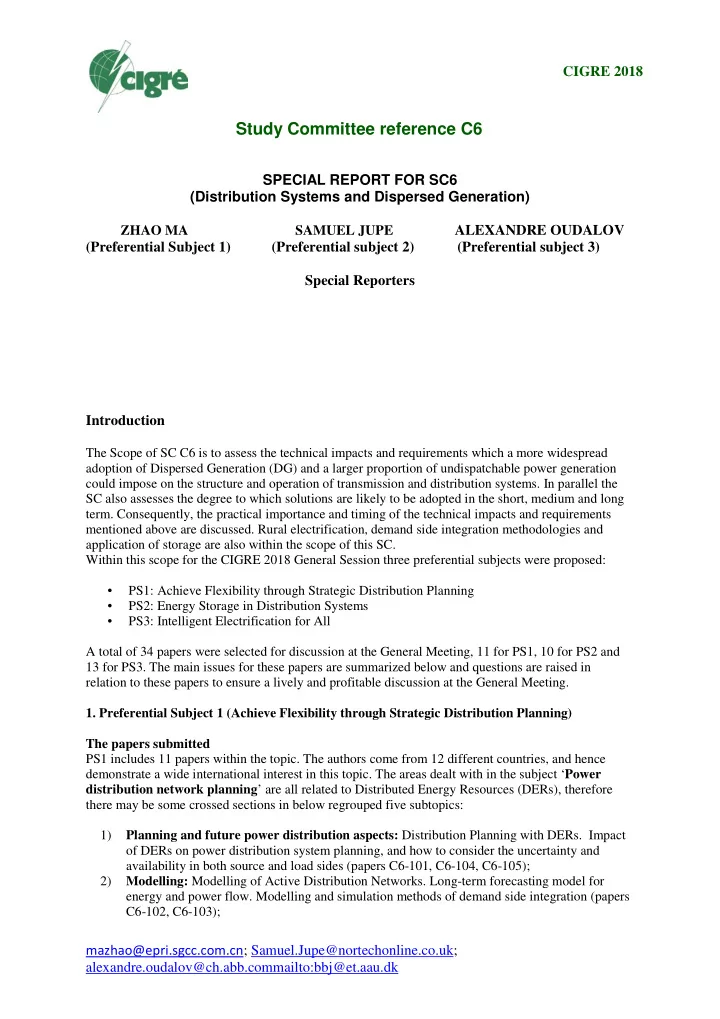

CIGRE 2018 Study Committee reference C6 SPECIAL REPORT FOR SC6 (Distribution Systems and Dispersed Generation) ZHAO MA SAMUEL JUPE ALEXANDRE OUDALOV (Preferential Subject 1) (Preferential subject 2) (Preferential subject 3) Special Reporters Introduction The Scope of SC C6 is to assess the technical impacts and requirements which a more widespread adoption of Dispersed Generation (DG) and a larger proportion of undispatchable power generation could impose on the structure and operation of transmission and distribution systems. In parallel the SC also assesses the degree to which solutions are likely to be adopted in the short, medium and long term. Consequently, the practical importance and timing of the technical impacts and requirements mentioned above are discussed. Rural electrification, demand side integration methodologies and application of storage are also within the scope of this SC. Within this scope for the CIGRE 2018 General Session three preferential subjects were proposed: • PS1: Achieve Flexibility through Strategic Distribution Planning • PS2: Energy Storage in Distribution Systems • PS3: Intelligent Electrification for All A total of 34 papers were selected for discussion at the General Meeting, 11 for PS1, 10 for PS2 and 13 for PS3. The main issues for these papers are summarized below and questions are raised in relation to these papers to ensure a lively and profitable discussion at the General Meeting. 1. Preferential Subject 1 (Achieve Flexibility through Strategic Distribution Planning) The papers submitted PS1 includes 11 papers within the topic. The authors come from 12 different countries, and hence demonstrate a wide international interest in this topic. The areas dealt with in the subject ‘ Power distribution network planning ’ are all related to Distributed Energy Resources (DERs), therefore there may be some crossed sections in below regrouped five subtopics: 1) Planning and future power distribution aspects: Distribution Planning with DERs. Impact of DERs on power distribution system planning, and how to consider the uncertainty and availability in both source and load sides (papers C6-101, C6-104, C6-105); 2) Modelling: Modelling of Active Distribution Networks. Long-term forecasting model for energy and power flow. Modelling and simulation methods of demand side integration (papers C6-102, C6-103); mazhao@epri.sgcc.com.cn ; Samuel.Jupe@nortechonline.co.uk; alexandre.oudalov@ch.abb.commailto:bbj@et.aau.dk
3) Operation and Control issues on the distribution network including demand integration, and on low-voltage systems (papers C6-107, C6-108, C6-109); 4) Load management method ‘Residential smart thermostats’ for potential energy savings. Study on smart meters-based load management method in low-voltage power distribution systems (papers C6-106, C6-111); 5) Asset management (papers C6-110). Subtopic 1 - Planning and future power distribution aspects (C6-101, C6-104, C6-105) The three papers deal with the impact of DERs on power distribution system planning and how to consider the uncertainty and availability in both source and load sides. The distribution grid structure and the integration of renewable and dispersed generation are concerned, but from different perspectives, e.g. the voltage issues (C6-104 and C6-105), and economic aspects such as payback time and net present value are also discussed (C6-101 and C6-104). Paper C6-101 ( Serbia , Utility/Manufacturer) discusses the procedure for expansion planning of distribution networks under uncertainty and variability in both generation and load. A number of extensive expansion plans and appropriate evaluations are required in order to minimize the risk of significant expansion costs. Fuzzy set concept, fuzzy mixed integer linear programming and applicable risk evaluation tools are used in this paper. The numerical results show the necessity of conducting a risk analysis in expansion planning, and demonstrate the potential to improve the planning process in radial distribution networks considering renewable energy and load variability and uncertainty. Paper C6-104 ( UK , Academia) discusses the management of DERs at the distribution level and the interaction with transmission networks. As the poorly coordinated decisions by participant and stakeholders, such as generators, energy storage operators, and network owners, will result in increased total cost of the power grid, it is suggested to set-up entities to govern the relationship between them. It is also argued in this paper that the arrangements for energy trading, system operation and network investment should follow a common set of principles that apply across voltage levels and are structured. Paper C6-105 (Germany, Manufacturers) presents the “Kopernikus initiative” which is supported by the German government since 2016. The project address the structure of distribution networks with renewable/distributed energy integration from different perspectives. The overall objective is to optimally balance investments in grid assets by applying intelligent operating approaches that enable direct use or storage of locally generated energy, or management of the demand side response as well. Question 1.1. What major factors should be considered when planning power distribution network with an increased penetration of Distributed Energy Resources (DER) including Demand Response (DR)? How should planning approaches be changed to take into account uncertainty and variability in both load and generation? How should this new environment be taken into account when deploying and dimensioning the new network structure and its associated management and operation? Question 1.2. What form will future developments and new planning strategies and methodologies take? How will these choices influence the design and deployment of future DER installations? Will these choices impact the nature, size and location of new DER installations? Question 1.3. How can the energy production processes take into account and manage the volatility of the power produced from renewable energy resources? How can flexibility be built into the generation units, thus helping to balance supply and demand in a future distribution grid? Would such a solution at the individual DER level be more cost effective than a local centralized solution handling a number of DER units operating at their optimal power point with no provision for balancing and energy firming? 2
Recommend
More recommend